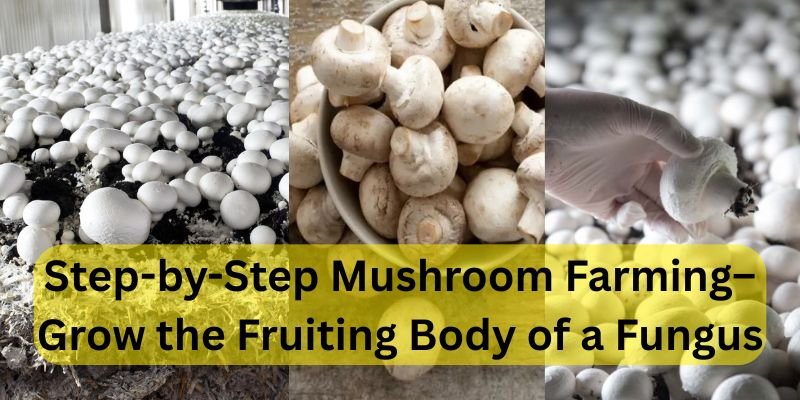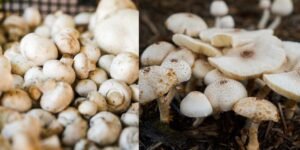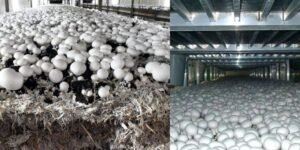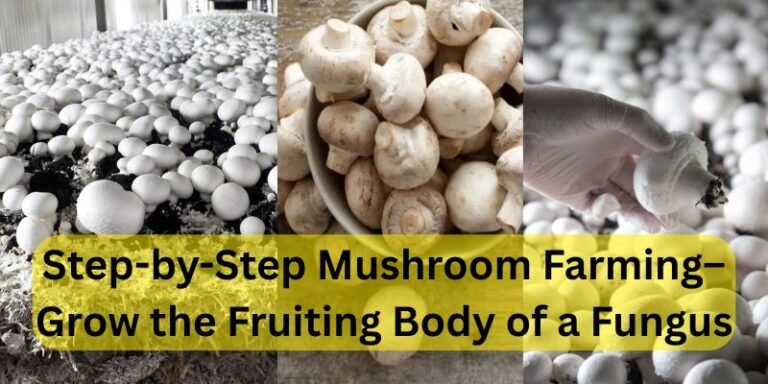
Faiz Khan
How to Grow Mushrooms at Home or Farm:- Mushrooms, the fruiting body of fungi, are gaining immense popularity as a nutritional, medicinal, and commercial crop. With low investment, minimal space requirements, and high returns, mushroom farming is a profitable agribusiness idea. This guide will help you understand the step-by-step process to start a mushroom farm from scratch.

1: Choose the Right Mushroom Variety
For beginners, start with varieties that are easy to grow and manage:
. Oyster Mushroom – grows quickly and requires minimal care.
. Button Mushroom – most commonly consumed, needs controlled temperature.
. Milky or Paddy Straw Mushroom – suitable for tropical climates.
Tip: Start with oyster mushrooms if you are new to farming.

2: Prepare the Growing Space
You don’t need expensive land or greenhouses. A small dark room, shed, or unused basement is sufficient.
. Temperature: 20°C to 28°C (varies by type)
. Humidity: 70%–90%
. Low light or indirect sunlight
. Good ventilation to avoid contamination
. Hygiene is critical. Wash hands, clean surfaces, and avoid pests.

3: Substrate Preparation
The substrate is the growing medium for mushrooms. Common substrates:
. Wheat straw
. Paddy straw
. Sawdust
. Cotton waste
How to prepare:
. Cut straw into small pieces (2–4 cm).
. Boil or soak in hot water to sterilize.
. Drain and cool before use.
. A clean substrate prevents fungal competitors and improves yield.

4: Spawn Inoculation (Seed Planting)
. Mushroom spawn is like the seed of the mushroom.
. Mix spawn with the cooled, damp substrate.
. Fill it into poly bags or trays.
. Tie and poke holes in the bag for air exchange.
. Maintain hygiene while handling spawn to avoid contamination.

5: Incubation (Mycelium Growth)
. Store bags in a dark, warm room (24°C–27°C).
. Leave for 2–3 weeks until the mycelium (white thread-like structure) fully spreads.
. No need for light or watering in this phase.

6: Fruiting Stage
. Shift bags to a humid, cooler room with some indirect light.
. Cut slits in the bags for mushrooms to emerge.
. Spray water 2–3 times a day to maintain humidity.
. Within 4–7 days, mushrooms will start fruiting.

7: Harvesting
. Harvest mushrooms before the cap opens completely.
. Use a sharp knife or twist gently by hand.
. Collect every alternate day during peak fruiting.

8: Packaging & Marketing
. Clean and pack in paper bags or plastic trays.
Store in a cool place or refrigerator.
Sell to:
. Local vegetable markets
. Grocery stores
. Restaurants
. Online platforms
Final Tips:
. Always maintain cleanliness to avoid pests and diseases.
. Monitor temperature and humidity regularly.
. Start small, learn, and then scale up for commercial profit.
Conclusion:
Mushroom farming is a low-risk, high-reward agricultural business that anyone can start with basic knowledge and hygiene. Whether you aim for personal consumption or full-scale commercial farming, this step-by-step process ensures a healthy, productive harvest.






